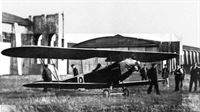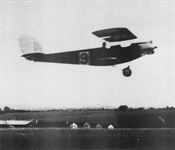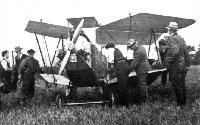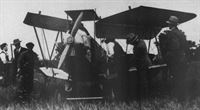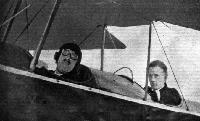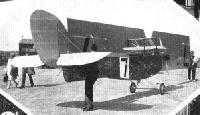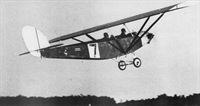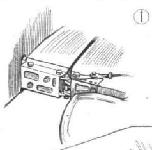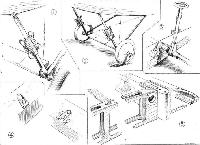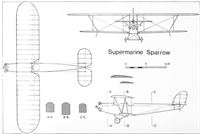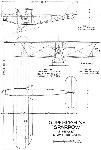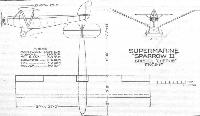
Flight, September 1924
THE SUPERMARINE "SPARROW" LIGHT BIPLANE (No. 9)
Blackburne Radial Engine
FOR the first time since the very early days of the firm the Supermarine Aviation Works of Southampton have produced a land aeroplane, all the energy of the firm having hitherto been devoted to the production of seaplanes or amphibian flying boats. It is, perhaps, significant that the first aeroplane of Mr. Mitchell's design should have been a light 'plane, and it is to be hoped that once he has started on light 'planes he will look into the problem of the light seaplane for which, if it be an engineering possibility, there should be at least as good a market as for light aeroplanes.
The Supermarine “Sparrow" is a tractor biplane with large top plane and small bottom plane; single-bay bracing with raked N-struts is employed, and the machine is fairly normal in every way. The power plant is a Blackburne radial engine. We would call attention to a small change which has been made in the rudder since our general arrangements were made. In the scale drawings a high, narrow and rather pointed rudder is shown, while in the photograph it will be seen that the rudder actually fitted is of a more rounded shape.
The fuselage of the Supermarine "Sparrow" is a flat-sided ply-wood covered structure with cambered deck. The top longerons do not, as is usually the case, run quite horizontally, but slope upwards slightly from a point behind the rear cockpit to the stern post. A somewhat similar arrangement is sometimes met with in ships' 'planes, the object being, of course, to allow the machine to pull up very quickly owing to the very large angle which the wings form with the ground. Presumably much the same object was in the mind of Mr. Mitchell when he designed the "Sparrow," and the very large angle, plus the fact that variable flap gear is fitted, should enable the Supermarine biplane to do rather well in the getting off and alighting competitions, as well as in the slow-speed tests. Not that there is any reason to expect that the machine will be inferior in the matter of top speed, but with a wing loading of rather less than 3 1/2 lbs./sq. ft. and fairly standard biplane bracing, it is to be expected that it will shine at the lower rather than at the high end of the scale. On the other hand, Mr. Mitchell has chosen the somewhat unusual arrangement of having different wing sections on top and bottom 'planes, and it appears likely that in this way it is in the power of a designer to make not inconsiderable changes in the slope and shape of the biplane L/D curve.
However, this is rather digressing from the subject of the construction of the Supermarine "Sparrow." Except for the cocked-up rear portion the body is of normal type, and this may be said also of the wing construction. The spruce spars are of I-section, the ribs of standard design, and the drag bracing of piano wire with compression ribs of specially reinforced construction. The ailerons run the whole length of the wings, and are fitted on both planes. Only the lower flaps are operated by cables and cranks, the movement being transmitted to the top ailerons by two struts on each side. The flaps, as already pointed out, are used as variable camber devices, the method of operating them being particularly simple. On the longitudinal rocking shaft carrying the "joy-sticks" is mounted a short column from which run the aileron cables. The inner ends of these cables are attached to a short yoke, having an internal thread engaging with a vertical worm. The upper end of this worm carries a hand wheel, by the rotation of which the yoke is raised and lowered, thereby pulling in or paying out the aileron cables. One of our sketches shows the camber gear.
The undercarriage has telescopic front legs, carrying crutches over which is wound rubber cord. The crutches are protected by leather gaiters, as indicated in Figs. 1 and 2. The axle is enclosed in a streamline fairing.
The three-cylinder Blackburne engine is neatly cowled-in all but the top of the cylinders and the oil sump, built integral with the crank-case. The petrol tank is housed in the deck fairing, and provides direct gravity feed.
Taking it all round, the Supermarine is a sound, straightforward machine, with but few experimental features, but incorporating several very sound ideas. From the user's point of view, the machine should appeal on account of its simplicity, and also for the fact that with the biplane arrangement chosen the view from both cockpits is exceptionally good. The machine should be reasonably cheap to build in quantities.
Описание:
- Flight, September 1924
THE SUPERMARINE "SPARROW" LIGHT BIPLANE (No. 9) - Flight, September 1926
British Light ‘Plane Development & Lympne Meeting
Фотографии
-
Aeroplane Monthly 1985-09 / R.Riding - Supermarine Sparrow /British pre-war ultralights/ (54)
THE SUPERMARINE "SPARROW": Three-cylinder Blackburne engine. Three-quarter front view.
The Supermarine Sparrow in its original 1924 Lympne form, with 35 h.p. Blackburne Thrush engine. The fuselage was doped dark blue with aluminium wings, tail unit and engine cowling. -
Aeroplane Monthly 1985-09 / R.Riding - Supermarine Sparrow /British pre-war ultralights/ (54)
At Lympne: Testing the Blackburne engine of the Supermarine "Sparrow."
A later photograph showing a slightly different paint scheme. -
Aeroplane Monthly 1985-09 / R.Riding - Supermarine Sparrow /British pre-war ultralights/ (54)
An early photograph of the Sparrow airborne with Biard flying from the rear seat.
-
Flight 1924-09 / Flight
Not a Helicopter, but the Supermarine "Sparrow" light biplane, with wings partly folded. Note the three-cylinder Blackburne engine. The man on the left, who appears to be threatening Mr. Mitchell with a club, is not, we hope, really in earnest.
-
Aeroplane Monthly 1985-09 / R.Riding - Supermarine Sparrow /British pre-war ultralights/ (54)
The Sparrow's wings being unfurled for flight - note how the top ailerons fold downwards. The man on the far left who appears to be threatening R. J. Mitchell with a blunt instrument is doing no such thing.
-
Flight 1924-10 / Flight
General Sir Sefton Brancker looks thoroughly pleased after a flight with Capt. Biard in the Supermarine "Sparrow."
-
Flight 1926-09 / Flight
No. 7. THE SUPERMARINE "SPARROW II": Three-quarter front view. Note the square wing tips.
-
Flight 1926-09 / Flight
THE FIRST OF THE ELIMINATING TESTS AT LYMPNE: Some of the competing machines photographed during the folding, housing and re-erecting test. 3, the Supermarine "Sparrow II" which has its wings in one piece and must be transported as shown.
-
Aeroplane Monthly 1985-09 / R.Riding - Supermarine Sparrow /British pre-war ultralights/ (54)
For the Lympne light plane meetings of 1924 and 1926, the Supermarine firm produced the little Sparrow, one of the very few landplanes turned out by them.
Seen competing at the 1926 Lympne trials is the Sparrow in its monoplane Mk II form with 32 h.p. Bristol Cherub III engine. -
Aeroplane Monthly 1985-09 / R.Riding - Supermarine Sparrow /British pre-war ultralights/ (54)
Регистрационный номер: G-EBJP Rare photograph of the Sparrow II wearing its registration letters, taken possibly at the time it was owned by the Halton Aero Club.
-
Flight 1924-10 / Flight
SOME MORE CONSTRUCTIONAL DETAILS FROM LYMPNE: (1) Hinge on lower rear spar for folding wings of Supermarine "Sparrow."
-
Flight 1924-09 / Flight
SOME SUPERMARINE "SPARROW" CONSTRUCTIONAL DETAILS: 1 shows one of the telescopic legs of the undercarriage. The crutches are covered with leather. 2, the complete undercarriage. 3, the very simple device for setting the wing flaps. Rotating the small wheel shortens or lengthens the positive cables the balance or return cables having rubber cords so as to adapt themselves to the varying length. In 4 is shown an aileron hinge, while 5 shows the construction of the lower plane.
-
Flight 1924-09 / Flight
Supermarine "Sparrow" 2-seater Light Biplane
-
Flight 1926-09 / Flight
Supermarine "Sparrow II" Bristol "Cherub" Engine
- Фотографии
